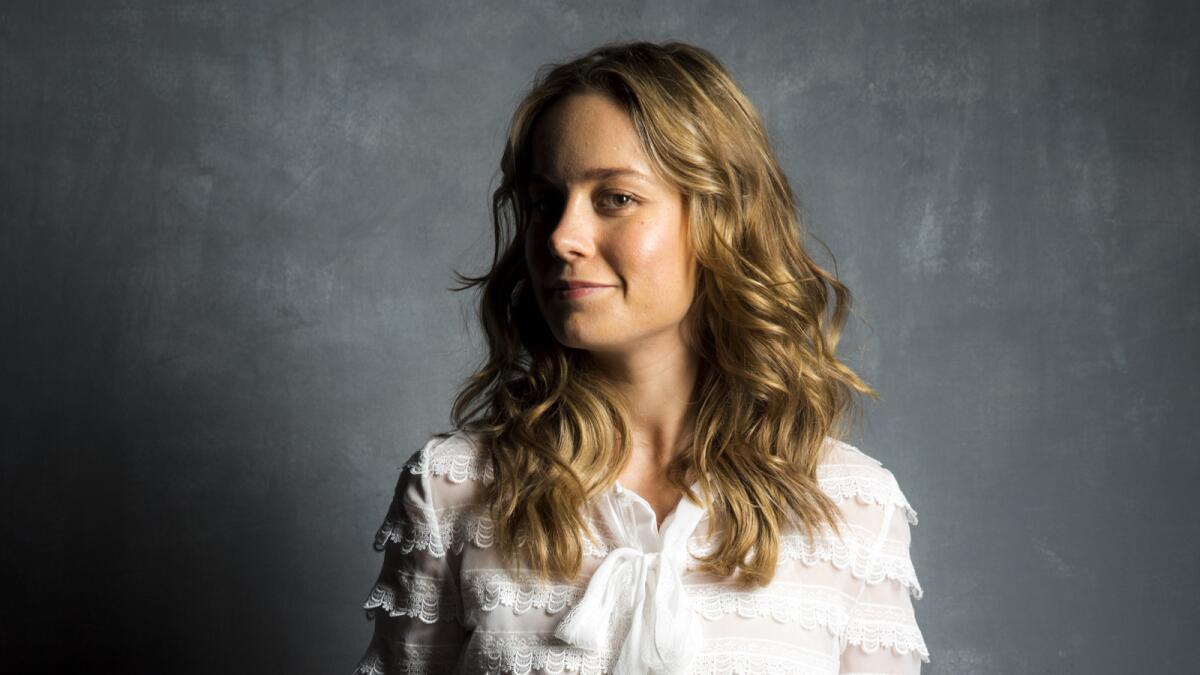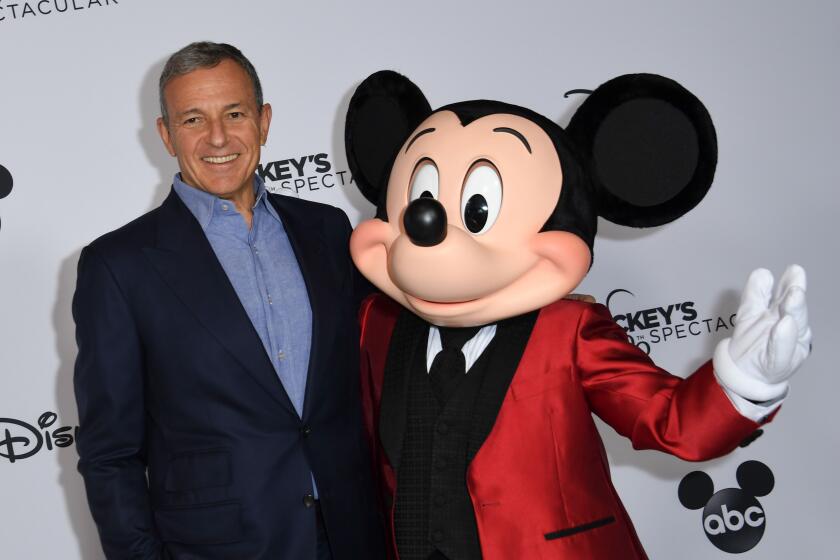At Toronto, film adaptation of Emma Donoghue’s ‘Room’ looks to break out

Emma Donoghue’s “Room” stars Brie Larson.
Reporting from TORONTO — A person held against their will. In a confined space. With only occasional glimpses of the outside world or memories of a time before a tortuous present.
It sounds like pretty much every Hollywood award show ever created. And it is. It’s also the backdrop for “Room,” a movie which, with a rousing screening at the Toronto International Film Festival Tuesday night, aims to make its mark on said ceremonies.
You’ve likely heard of the book, or movie, or both. (Check out my colleague Rebecca Keegan’s story on the film here.)
Adapted by Emma Donoghue from her own bestseller, the film stars Brie Larson and the 8-year-old-newcomer Jacob Tremblay in a pair of career-making turns. “Room” centers on Joy (Larson), a woman held captive for seven years in a shed, raising a child (Tremblay) she bore after being raped by her captor (Sean Bridgers). Attempts to escape meet with unexpected consequences, as the film contemplates the perils of both captivity and freedom, while exploring one of the most tender and unexpected mother-child relationships in recent memory.
SIGN UP for the free Indie Focus movies newsletter >>
Directed by the Irish indie filmmaker Lenny Abrahamson, “Room” tells its story from the point of view of Jack, who is processing the world with the speaking abilities of a 5-year-old but the naivete of someone much younger. He distinguishes between items that are real, in “room,” and those that are “TV”—essentially anything or anyone that doesn’t relate to his immediate sphere.
As the film unfolds, it is his fresh-eyed perspective on the world, and dawning realization of events around him, that provide both narrative information and emotional power. Joy, for her part, shows a mix of resolve and, occasionally, resignation, as the horror of her circumstance bears down on her.
Abrahamson previously made the offbeat dramedy “Frank,” in which Michael Fassbender plays an enigmatic rocker who never takes off a cartoonish mask, and he is a somewhat under-the-radar choice for this movie. (He won the gig by directly appealing to Donoghue.)
FULL COVERAGE: Toronto, Telluride and more film festivals
But as the director took the stage in Toronto on Tuesday, he explained there are some parallels to his earlier work.
“‘Frank’ is about someone trapped inside a head and emerges, and this is about two people trapped inside a room,” he said. “I guess I’m always interested in people who are having marginal experiences or are themselves marginal. You see a lot of someone when they’re under [that kind of] pressure.”
Donoghue, meanwhile, sought to build out the world in unexpected ways from her novel, particularly via Joy’s character. “I hate to sound disloyal to fiction as a form, but it has come to my attention that there are places only cinema can reach,” she said dryly at the screening.
See the most-read stories in Entertainment this hour >>
“Room” is a genre movie with larger themes, coming in the spirit of several such hits in recent years (see particularly under 2013’s “Prisoners,” which investigates similar issues of power and parental protectiveness). The film is about far more than its straightforward premise, and there is much latitude to interpret it on geopolitical, feminist and even Freudian grounds. (The idea of a child emerging from “room,” a confining but also comforting space, has a clear parallel to a womb, to take a more obvious subtext.)
If it can be uncomfortable to watch, “Room” wasn’t necessarily fun or easy to make.
Abrahamson and his team--they include longtime editor Nathan Nugent and several others--filmed the proceedings with a kind of intentional claustrophobia. The scenes in “Room” often are done in extreme close-up, the camera rarely pulling back to reveal the whole environment. (To construct the room, the production built an entirely movable space of LEGO-like breakability, allowing the camera to obtrude anywhere at any time.) The idea was that the less we can situate ourselves in the room, particularly early on, the more disoriented and hemmed-in we’d end up feeling.
Shot over about 60 days, the film also used some improvisation, something of an anomaly for a work in which a child appears in nearly every frame. Abrahamson and his team did try to bake in some humor, if only to relieve the tension; even horrifying movies need to give the viewer a respite once in a while. On Tuesday the audience responded by registering even minute beats of comedy with a full-on reaction.
Larson said at the Q&A that she also thought the movie benefited from Abrahamson’s nurturing qualities. “I wanted to work with someone who loved life and loved humanity and loved children and dogs,” she said. The actress, who caught the attention of many with her turn in “Short Term 12” in 2013, has already spoken of her emotional response reading the book. She continued that theme at the Q&A Tuesday, again citing only one other novel that made her cry in this way, Wilson Rawls’ “Where the Red Fern Grows,” which she read as a child.
Also at the event, Bridgers, continuing in a long line of actors (Osama bin Laden in “Zero Dark Thirty” and the terrorists in “United 93”) who can horrify you with the real-life presence even though you know they’ve just been pretending, sent up the usual it-was-so-fun-to-work-together bromides of the post-screening chat.
“For me, I can’t say it was a joy,” the actor said to laughter.
How far “Room” can go at both the box office (A24 brings it out on Oct. 16) or on the awards circuit remain one of the more interesting questions of the upcoming season, in which movies featuring huge stars and big canvasses (“The Martian,” “The Revenant,” “Steve Jobs,” “Black Mass”) will all be taking up plenty of real estate.
“Room,” on the other hand, is small in scope. But it is large in theme, something voters tend to like. And there is space for a darker indie movie at the best picture table--think “Winter’s Bone” or “Precious”--though that does hinge on building a more grassroots bloc of support.
As Abrahamson told The Times at the post-screening party Tuesday, the trick will not so much be getting people to vote for the movie once they’ve seen it but getting them to see it in the first place--to make them realize that “it’s not what they think it is.”
After all, the film has warmth too. “I really made this as a love letter to my son,” the director said. Viewers will likely feel that affection. Now the question is how many viewers, and how deeply they return the favor.
MORE:
Toronto 2015: ‘Danish Girl’ with Eddie Redmayne stirs Oscar talk again
Toronto 2015: Sandra Bullock and George Clooney on gender switches and ‘butt doubles’
More to Read
Only good movies
Get the Indie Focus newsletter, Mark Olsen's weekly guide to the world of cinema.
You may occasionally receive promotional content from the Los Angeles Times.











